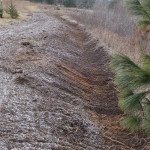
Small equipment can be used to create swales that keep run-off water from directly entering the pond that contains excessive nutrients and organic material.
Do you want to protect your property from flooding and drought?
What’s a swale? A swale is a excavated depression to slow, absorb and direct water. Swales can help you use and reuse water on your property.
March is a great time to talk about this since the snow is melting in northern climates and rain will start any day. One of the problems I see on many properties has to deal with water. Have you ever watched the news about some part of the country having a terrible drought? The next thing you read is the exact same area now has horrible flooding and mud slides. How can this be? Drought and flooding are cyclic. for thousands of years civilizations understood this cycle . They did things that lessened the effects of drought and reduced the impact of flooding that were in tune with nature by slowing water down.
However, for the last hundred years or so, we have done just the reverse in our land management because we had the equipment and fossil fuels to do it. We decided we wanted properties to shed water rapidly which makes them drier during droughts and causes flooding down stream when its wet. And guess what? We are always down stream no matter where we live.
Whether your property is small or large, swales can be rapidly constructed to help absorb precipitation into the soil. Swales can be any size, shape, on-contour or pitched. They can be constructed using anything as small as a spade or as large as a bulldozer.
Remember contour plowing for farm land? That is a form of swale that is very small, integrated into a crop field and is repetitious. We have constructed very shallow swales in mowed yards that are barely noticeable. Plants in sandy soils flourish in and around swales because of the extra moisture. Heavy soils benefit from swales by retaining their sponge-like ability to absorb water instead of becoming an impervious surface.
About the Author: Tom Girolamo is an author and owner of Eco-Building & Forestry, LLC., Central Wisconsin’s premiere sustainable landscape design service.

